Introduction
Migrating from on-premises infrastructure to cloud environments has become an essential strategic move for organizations aiming to enhance operational efficiency, scalability, and collaboration. This transition not only reduces capital expenditures related to hardware and maintenance but also positions businesses to leverage advanced technologies. Cloud platforms offer unparalleled scalability, enabling organizations to dynamically adjust resources to meet varying demands, an ability that proved crucial during the global pandemic.
Additionally, cloud-based collaboration tools have become indispensable for maintaining productivity in remote work environments. This article delves into the benefits of cloud migration, assessing current on-prem infrastructure, defining migration strategies, choosing the right cloud provider, preparing for migration, the data migration process, validating the migration, post-migration monitoring and optimization, training and support for end-users, and reviewing lessons learned from the entire process. By understanding each aspect, organizations can ensure a seamless transition and maximize the advantages of cloud adoption.
Benefits of Migrating from On-Prem to Cloud
Moving from on-premises infrastructure to a remote service provides several strategic benefits, including cost efficiency, scalability, and improved collaboration. By transitioning to online services, organizations can significantly decrease capital expenses associated with hardware and upkeep, utilizing the pay-as-you-go pricing model of these services. This shift allows for better financial planning and resource allocation, aligning IT investments with business needs.
The scalability provided by online platforms is unmatched. Organizations can dynamically adjust their resources to meet varying demands, ensuring optimal performance and cost management. This flexibility was particularly crucial during the global pandemic when companies had to quickly adapt to remote work environments. Hosting virtual desktop infrastructure (VDI) on public networks, using consistent VDI software like Citrix or VMware, enabled employees to securely access work resources from any device, significantly enhancing productivity and operational continuity.
Furthermore, cloud-based collaboration tools facilitate seamless remote work, fostering improved communication and efficiency among teams. These tools have become indispensable for modern businesses, enabling them to maintain high levels of productivity regardless of physical location. The system not only supports current operational needs but also positions organizations to leverage advanced technologies and drive business innovation.
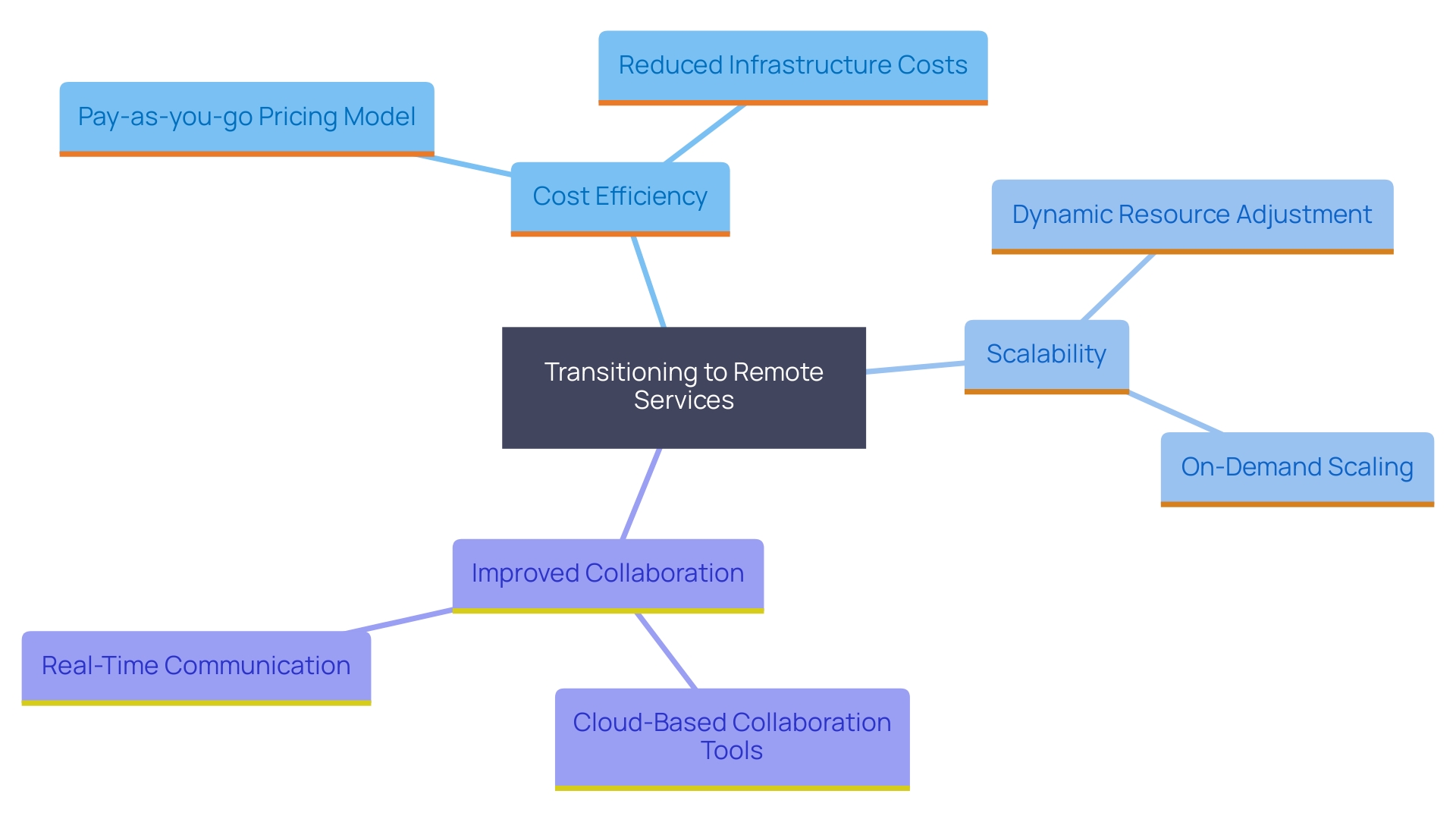
Understanding Your Current On-Prem Infrastructure
A comprehensive assessment of your existing on-premises infrastructure is essential before embarking on a cloud migration journey. This process involves meticulously documenting all hardware, software, programs, and network configurations. Leveraging assessment tools, such as scripts, questionnaires, and diagnostic instruments, can facilitate data collection and analysis. These tools provide valuable insights into performance, security, and compliance aspects of your IT environment.
Carrying out an evaluation assists in recognizing the dependencies between software and systems. It also ensures that any compliance requirements are clearly understood and addressed. By running these assessments, you gain clarity on your current state, including potential security vulnerabilities and application compatibility with cloud environments. This is crucial for a seamless transition and optimal performance during the process.
Moreover, detailed reports generated from these assessments outline the existing state of your IT infrastructure. These insights allow for performance optimizations, enhancing the efficiency and resource utilization of servers and workloads. Ultimately, understanding the current state through a thorough assessment informs your relocation strategy, ensuring that nothing critical is overlooked during the transition.
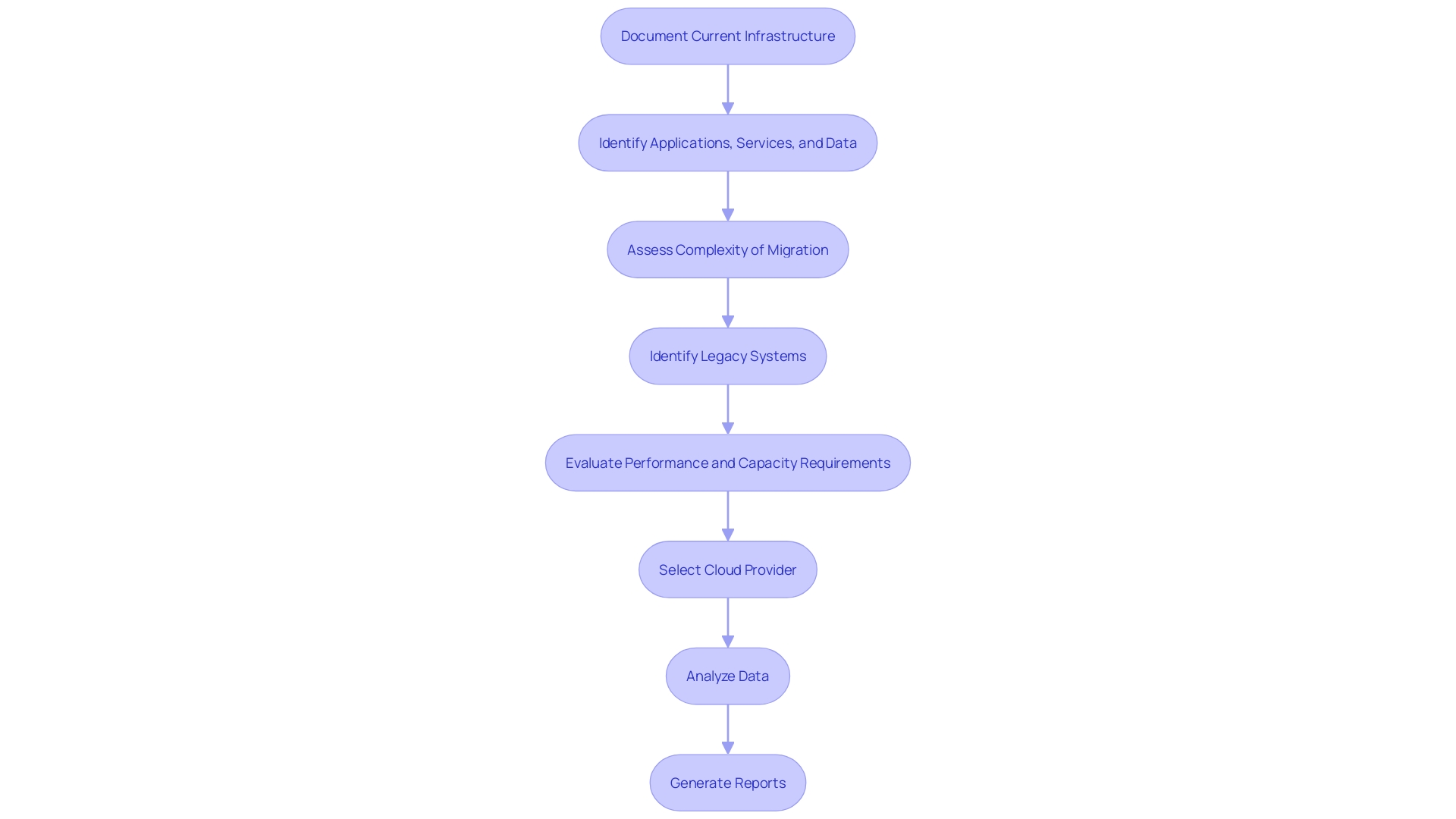
Defining the Migration Strategy
Establishing a migration plan for virtual services necessitates thorough evaluation of multiple elements, such as the immediacy of transition, the intricacy of current software, and the preferred online framework. Key strategies to consider are rehosting, refactoring, and rebuilding.
'Rehosting, often termed as 'lift-and-shift,' involves relocating software without significant changes.'. This strategy is typically quicker and easier but might not fully leverage cloud-native features. Refactoring, conversely, involves altering systems to better fit the online ecosystem, which can improve performance and scalability but requires additional effort and resources. Reconstructing, or developing new software directly in the online environment, provides the greatest opportunities for enhancement and creativity but requires considerable development effort.
Each of these approaches has distinct advantages and challenges. For instance, rehosting can provide immediate cost benefits, while refactoring and rebuilding can drive long-term efficiencies and innovation. To align your strategy with business goals, it's crucial to conduct a comprehensive cloud readiness assessment. Evaluate your current technology stack, application architecture, and data to understand the complexities involved.
As noted by Satyendra Kumar, adopting a multiprovider, multipartner strategy and ensuring collaboration across boundaries can be vital. Security considerations should be paramount, and creating detailed playbooks can facilitate knowledge sharing and streamline the transition process. Ultimately, the chosen strategy should reflect the unique needs and operational requirements of your organization, driving both immediate and sustained value.
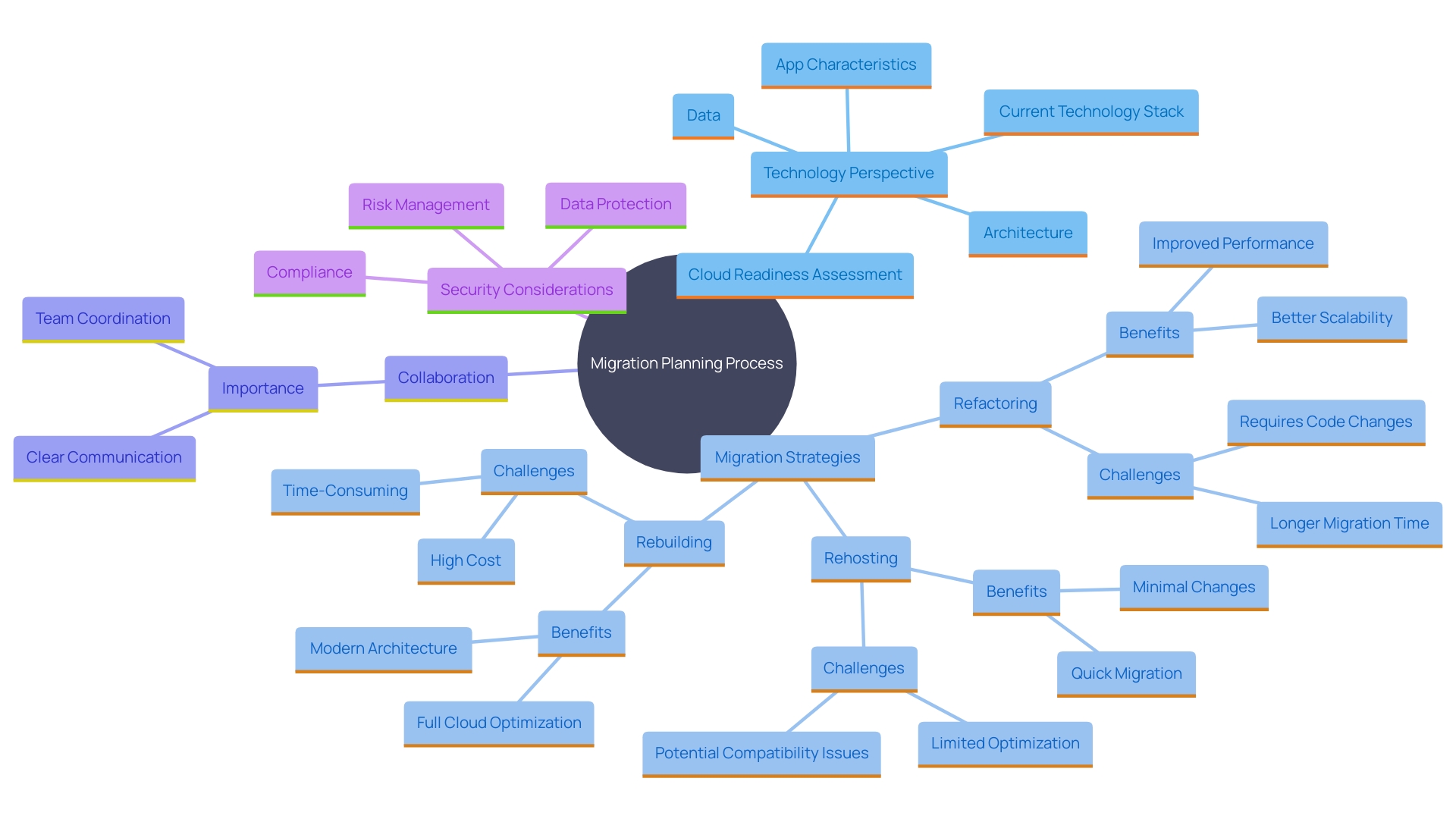
Choosing the Right Cloud Provider
Selecting the best service provider is essential for a successful migration. Focus on providers with a demonstrated history of reliability and robust security measures. Evaluate their service offerings to ensure they align with your organization's current and future needs.
Consider the provider's ability to support and scale with your growth. Scrutinize their pricing models and support services to ensure they fit within your budget and operational requirements. For instance, start-ups and ISVs often seek providers like DigitalOcean that cater specifically to their unique needs, such as building and scaling software efficiently.
Perform an extensive readiness evaluation to comprehend your existing infrastructure and future needs. This involves examining your technology stack, application characteristics, and data architecture. Work together with your selected provider to create a comprehensive transition strategy, ensuring a smooth transfer to the online environment.
By meticulously comparing potential providers and aligning their offerings with your strategic goals, you can secure a cloud partnership that supports and enhances your organization's growth trajectory.
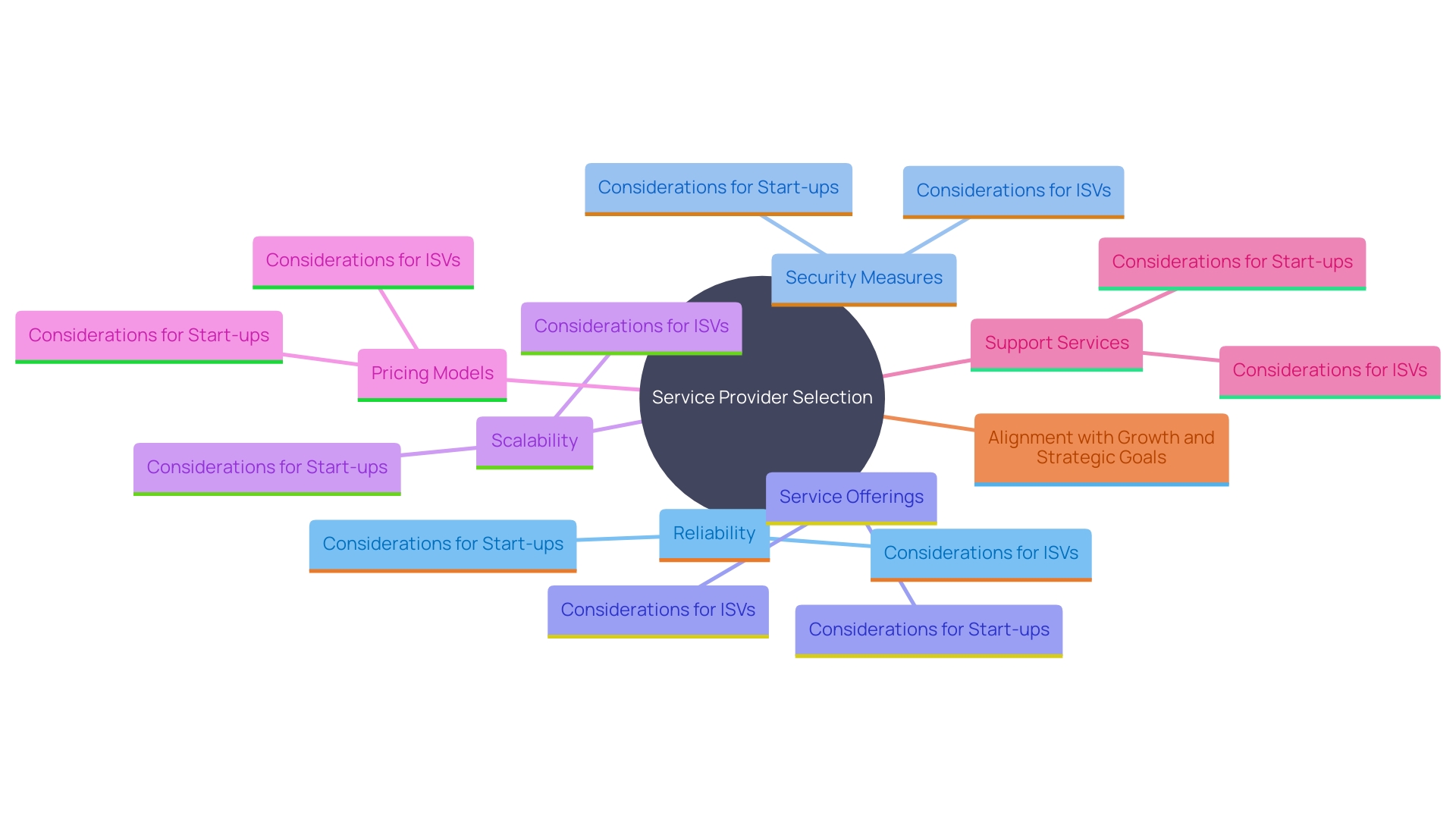
Preparing for Migration
Preparation for relocation involves setting up a detailed plan that includes timelines, resource allocation, and risk management strategies. Establish a dedicated migration team comprising IT staff, project managers, and stakeholders. This team should develop a comprehensive timeline that outlines key milestones and deliverables, ensuring that everyone is aligned and aware of their roles and responsibilities.
To begin, conduct a thorough audit of your current infrastructure to identify the necessary adjustments for a successful cloud transition. This audit should cover hardware, software, integration issues, and compatibility problems. Data-driven decisions are crucial; therefore, rely on analytics to determine which systems and applications are essential and which can be phased out. Key metrics include system performance, user engagement, and operational relevance.
The relocation team must also engage with various departments to gather feedback on current systems and identify any challenges. This collaborative approach ensures that the transition plan aligns with business goals and addresses all critical aspects of the existing infrastructure. Consistently assessing and revising the transition roadmap will assist in maintaining the project's direction and adapting to any alterations in technology or business needs. The roadmap should clearly outline the stages of transition, each with specific objectives, tasks, and milestones to track progress effectively.
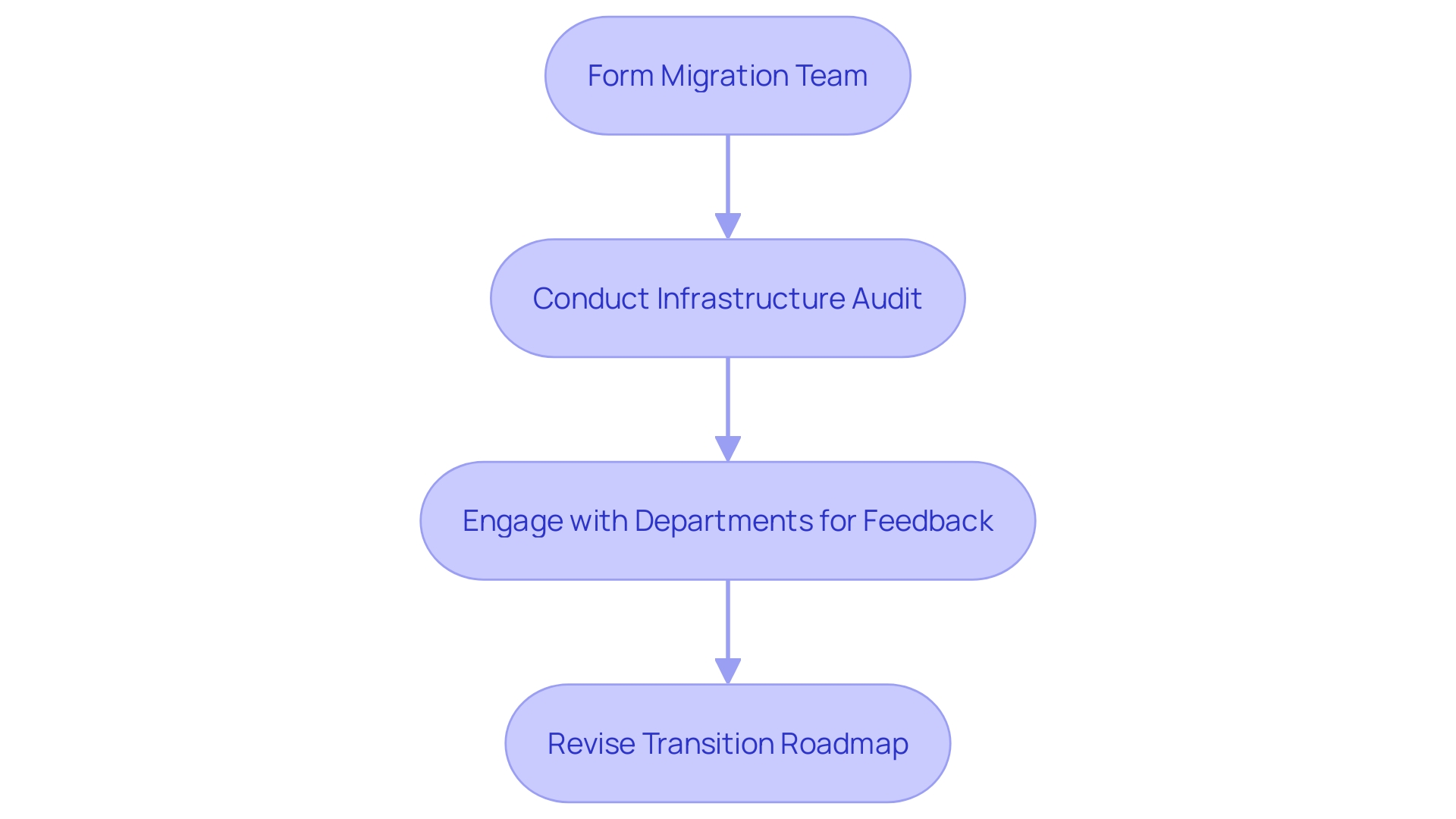
Data Migration Process
'The information migration process is pivotal in transitioning to the cloud.'. Begin by organizing information according to its significance and sensitivity, ensuring integrity throughout. 'Engage with external IT providers specializing in legacy information management, as partnerships can be crucial for success.'. For instance, Harmony Healthcare IT was instrumental in maintaining secure access to historical records during a significant transition.
Utilize strong information transfer tools to aid the movement, and include a flexible strategy that combines automation and manual methods. Develop a thorough transition strategy outlining each phase, incorporating extensive testing to confirm successful transfers prior to launching. Security should be a primary focus, involving close collaboration with all key partners to meet current standards. By establishing a dedicated team for information validation, you can ensure accuracy and continuity, which is critical for maintaining high quality. This organized method, backed by professional teamwork, will assist in attaining a smooth and secure transition to online services.
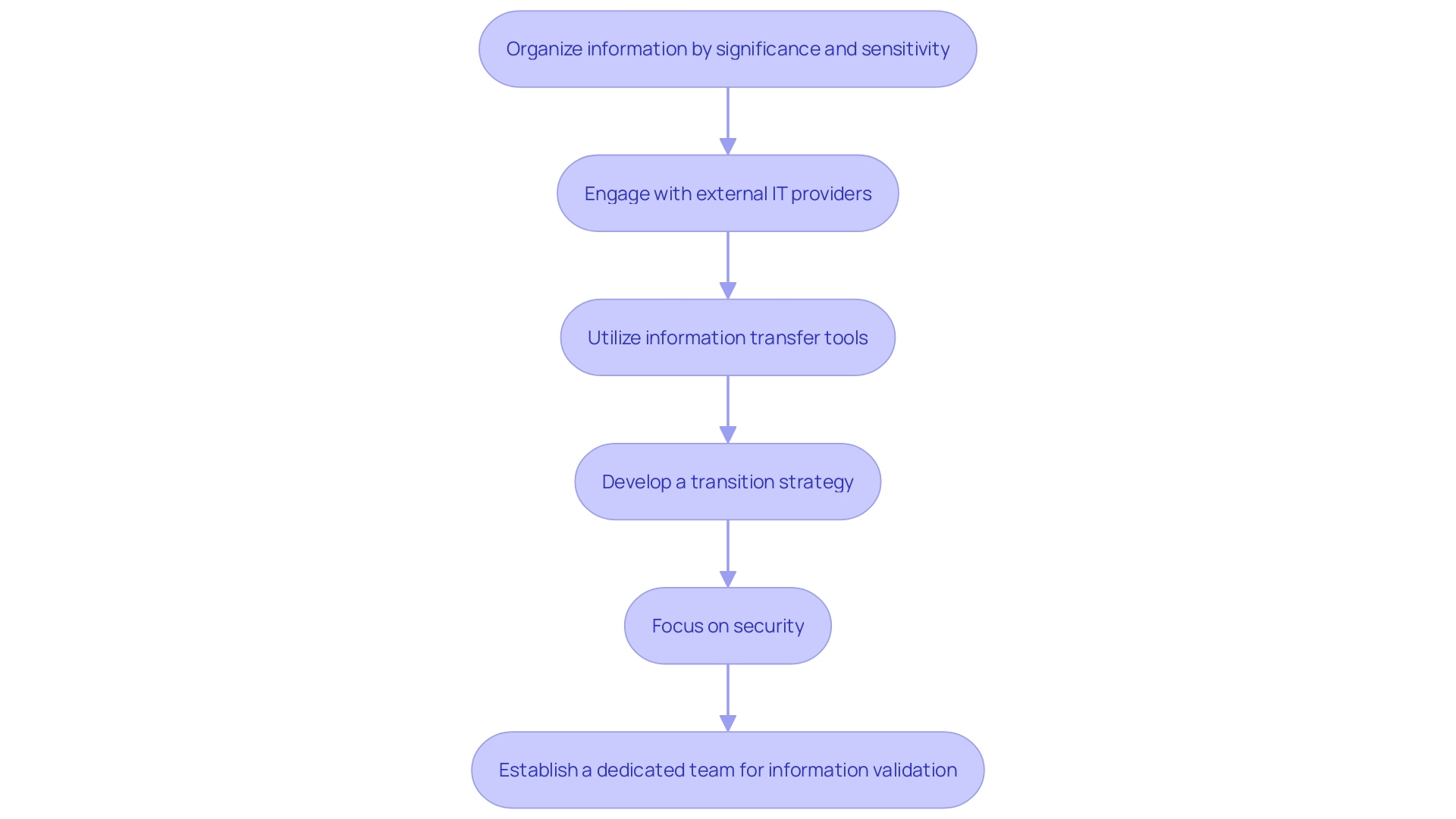
Validating the Migration
Post-migration validation is crucial to confirm that all systems are operating as expected. This involves extensive testing to ensure that programs and information have been successfully migrated. It's essential to verify that performance metrics align with the anticipated benchmarks. Engaging end-users during this phase is vital to collect feedback and swiftly address any issues that emerge.
The success of a digital migration often depends on adjusting the organization's technology, processes, and people. A comprehensive preparedness evaluation should encompass reviewing your existing technology framework, software attributes, architecture, and information integrity. This is particularly important for applications built on unique hardware not represented in the cloud, such as specific IoT applications.
Data quality plays a significant role in the overall success of IT systems post-migration. 'Ensuring high standards of information consistency, accuracy, reliability, and completeness can lead to improved decision-making and operational efficiency.'. Conversely, poor information quality can result in inaccurate analytics and operational challenges, hindering the organization from reaching its full potential.
Integrating real-world feedback and thorough evaluation during the post-migration phase aids in refining the system and preserving information quality. As highlighted by industry experts, maintaining high data quality standards is essential for the success of the IT ecosystem.
Monitoring and Optimization Post-Migration
Ongoing observation after migration is essential for guaranteeing optimal performance in the environment. Utilizing advanced online monitoring tools is essential to effectively track resource usage, performance metrics, and potential issues. By regularly reviewing these insights, organizations can pinpoint areas for optimization, such as resizing instances or adjusting configurations. This proactive approach not only enhances operational efficiency but also significantly reduces costs. As Chief Analyst Roy Illsley noted at Data Center World 2023, the integration of AI in monitoring systems can further streamline operations and enhance decision-making processes.
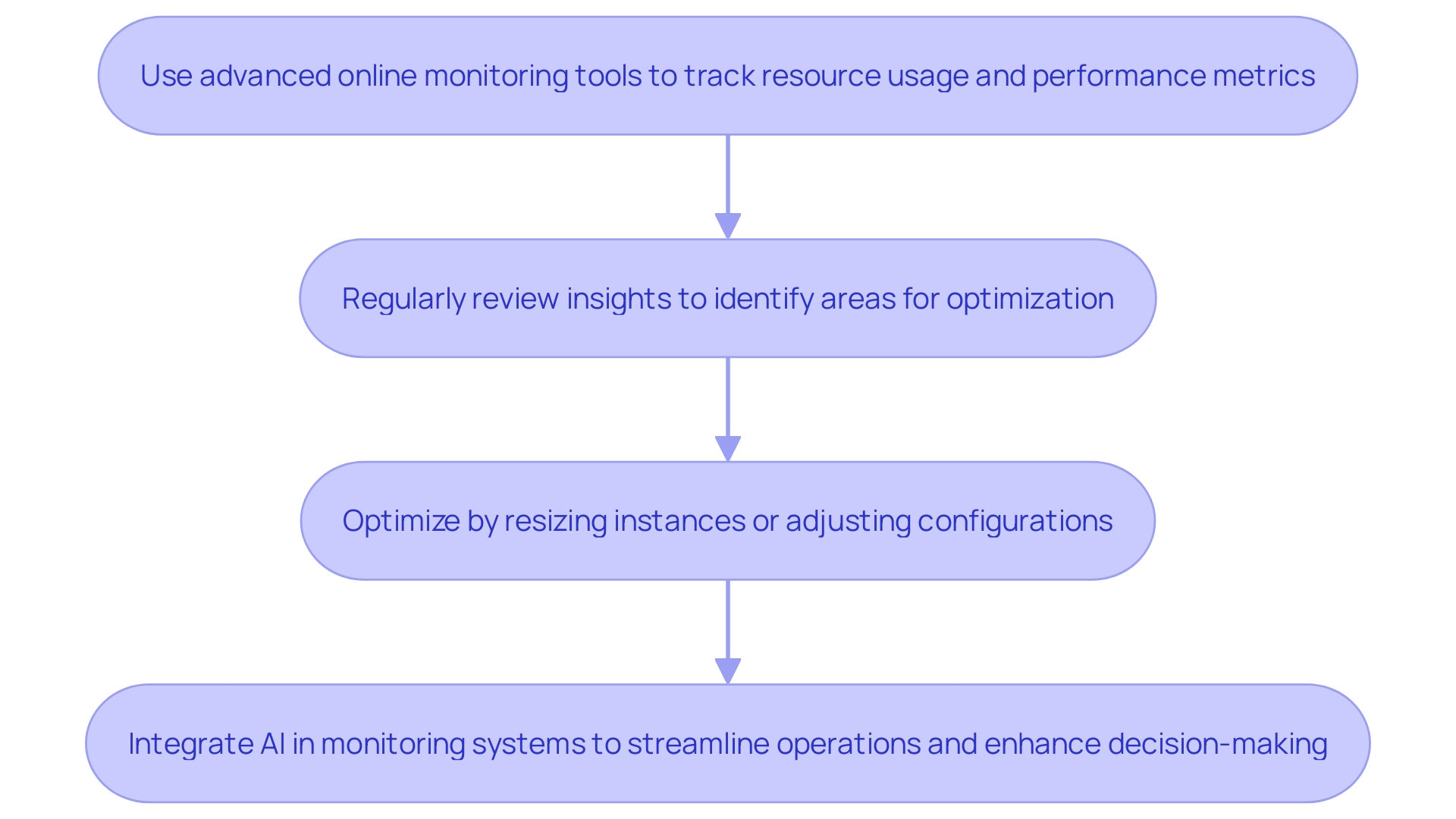
Training and Support for End-Users
Providing thorough education and assistance for end-users is crucial to the success of any online transition. Developing tailored training programs that familiarize employees with new systems and tools is a critical step. This approach not only mitigates the initial learning curve but also builds a foundation for long-term productivity.
Ongoing support mechanisms, such as help desks and chatbots, play a vital role in addressing any questions or concerns that may arise post-migration. According to industry expert Satyendra Kumar, a dynamic blend of automation and manual processes, alongside thorough planning, is essential for effective migration. This sentiment is echoed in the strategies adopted by organizations like the National Bank of Canada, which emphasizes the importance of collaboration and continuous support to enhance client experience and operational excellence.
Additionally, showcasing the technology as a catalyst for attaining enhanced efficiency and flexibility can greatly enhance workforce engagement. As emphasized by David S. Linthicum, effective workforce enablement is not merely a best practice but a key factor in ensuring the organization’s investment success. By aligning technology adoption with comprehensive training and support, organizations can not only facilitate a smoother transition but also enhance overall productivity, thereby maximizing their return on investment in digital technologies.
Review and Lessons Learned
Conduct a comprehensive post-migration review to analyze the entire process meticulously, identifying both successes and areas requiring improvement. This review should incorporate feedback from all stakeholders involved, including IT teams and end-users. Recording the lessons acquired is essential for improving future migration initiatives and enhancing your organization's overall strategy. As David S. Linthicum emphasizes, assessing your readiness for online services from a technology viewpoint requires examining your existing technology stack, software traits, architecture, and data. This examination is essential as migrating applications built on unique hardware that cannot be virtualized, such as specific IoT apps, can be particularly challenging. Additionally, a recent Citrix survey reveals that 25% of organizations have moved half or more of their cloud-based workloads back to on-premises infrastructures, often due to security issues and unmet project expectations. Therefore, understanding these challenges and preparing accordingly can significantly enhance the success of your cloud migration strategy.
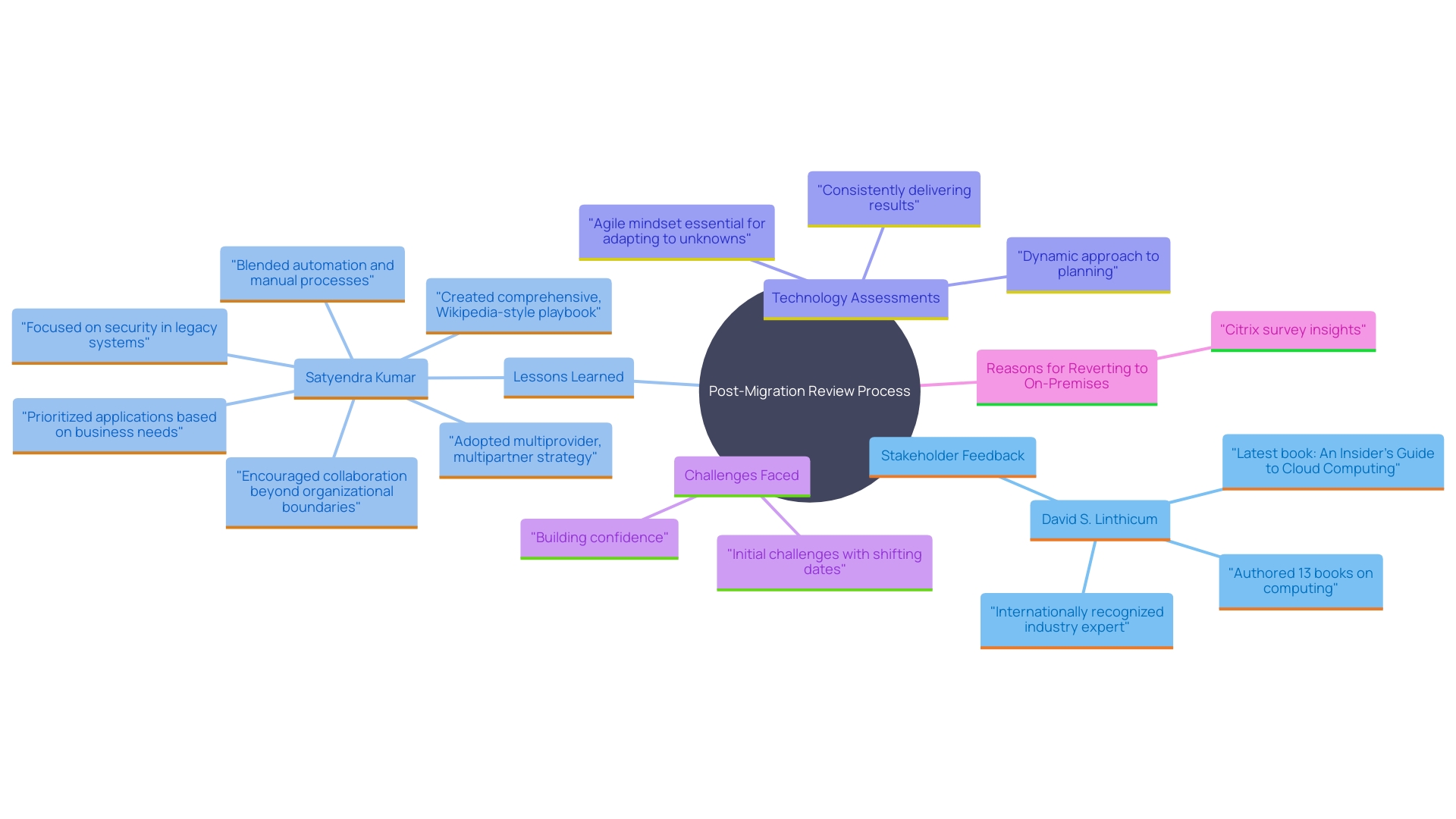
Conclusion
Migrating from on-premises infrastructure to the cloud presents significant advantages, including cost efficiency, scalability, and improved collaboration. This transition allows organizations to reduce capital expenditures while dynamically adapting resources to meet changing demands, especially in remote work environments. Effective cloud-based collaboration tools are vital for maintaining productivity among distributed teams.
A thorough assessment of existing on-premises infrastructure is essential for a successful migration. This process identifies dependencies, security vulnerabilities, and compliance needs, guiding the development of a tailored migration strategy. Choosing the right cloud provider is also critical, as their offerings must align with organizational goals to support future growth effectively.
Preparation involves meticulous planning and resource allocation, while the data migration process must focus on data integrity and security. Post-migration validation and continuous monitoring are crucial for ensuring that systems operate as intended and that performance metrics are met. Providing adequate training and support for end-users is key to maximizing productivity during this transition.
Finally, conducting a comprehensive review of the migration process and documenting lessons learned will enhance future strategies. By understanding successes and challenges, organizations can refine their cloud adoption journey, driving innovation and operational excellence. This strategic shift not only addresses immediate needs but also positions organizations for greater agility and responsiveness in an increasingly dynamic business landscape.




